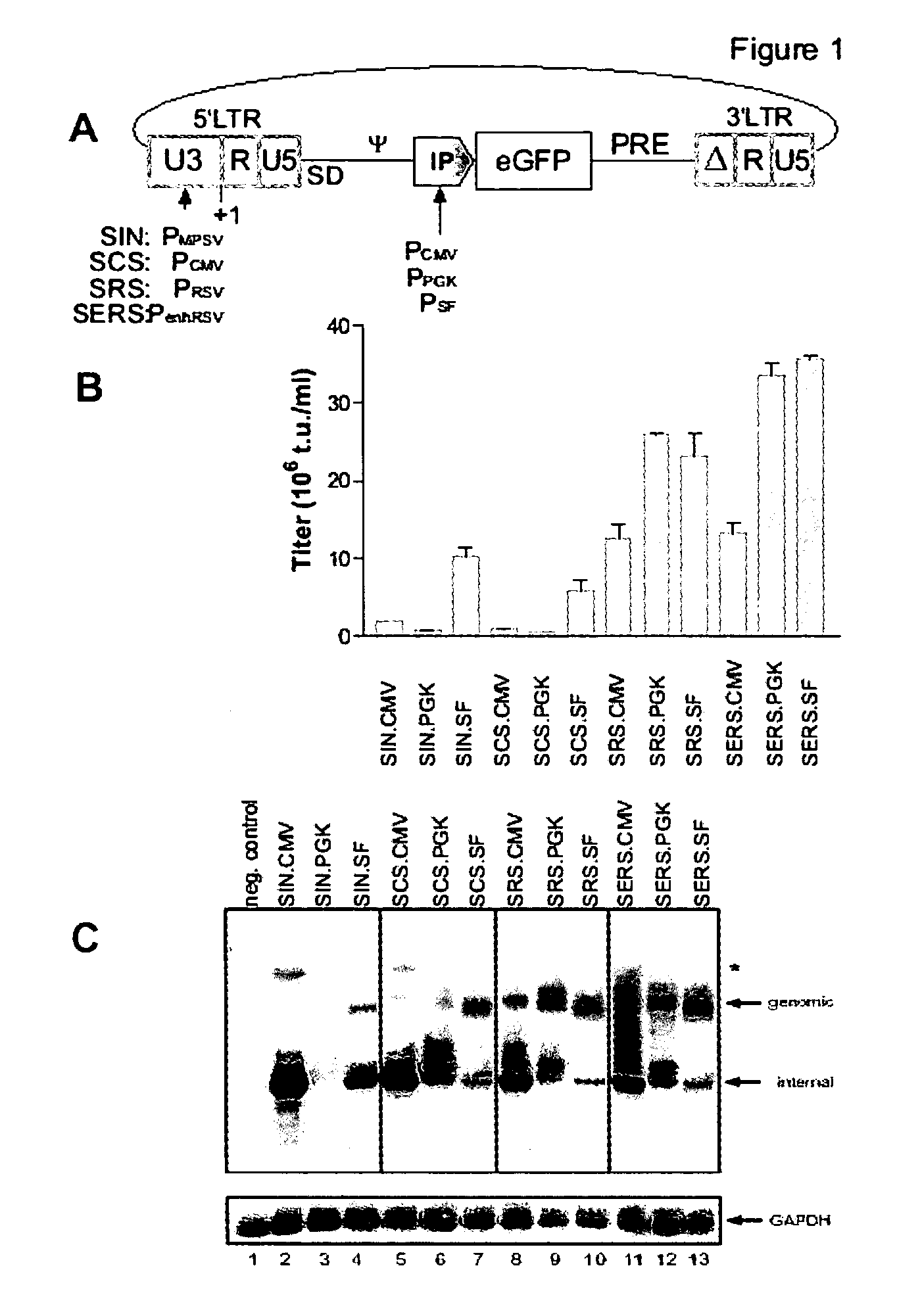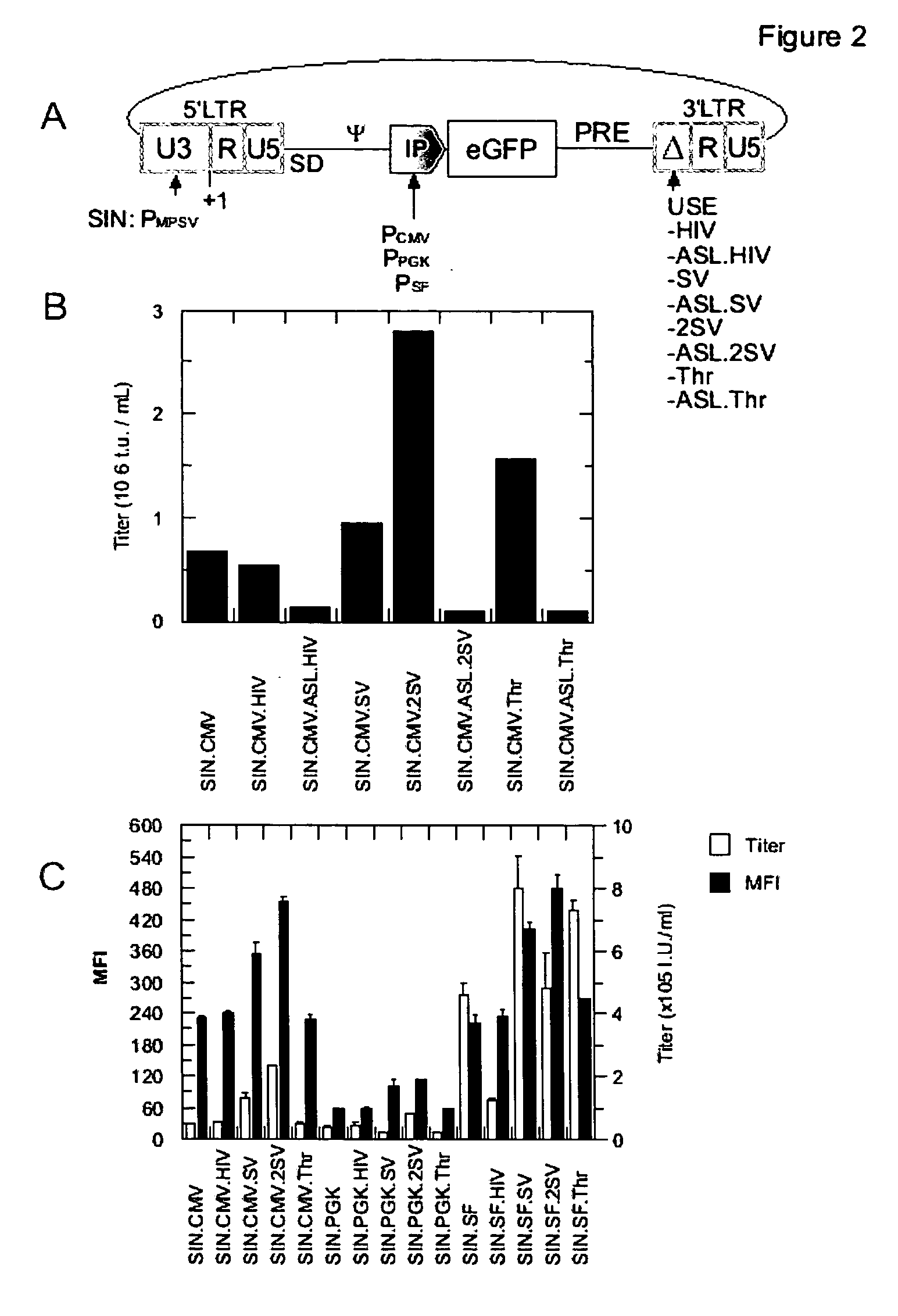Self-inactivating retroviral vector
- Summary
- Abstract
- Description
- Claims
- Application Information
AI Technical Summary
Benefits of technology
Problems solved by technology
Method used
Image
Examples
example 1
Identification of 5′ Promoter Dominating Potential Internal Promoters of 5′-SIN-LTR
[0079] When investigating ways to enhance the titer of gammaretroviral vectors suitable to be produced at high titers in permissive packaging cells, the original promoter element derived from Myeloproliferative Sarcoma Virus (PMPSV) present in the state-of-art 5′-SIN-LTR (termed SIN in vector designations) was replaced by a variety of promoter elements.
[0080] A schematic representation of said vectors is given in FIG. 1 A, wherein the promoter from cytomegalovirus (PCMV) replaces the MPSV promoter element (PMPSV), resulting in a novel 5′-promoter termed SCS. When replacing the MPSV promoter with the promoter element from Rous Sarcoma Virus (PRSV), resulting in a 5′-promoter termed SRS, and a further construct by adding enhancer sequences obtained from Simian Virus 40 (enh) to the PRSV, a 5′-promoter termed SERS (enhPRSV) was obtained. Each of these derivatives of the original PMPSV-containing SIN el...
example 2
Improvement of Titer by Modification 3′-SIN-LTR
[0085] In order to further improve the titer of retroviral vectors, the 3′-SIN-LTR is modified in its U3-region to contain an upstream signal enhancer (USE) element that promotes transcriptional termination and poly-adenylation. As a starting point for this aspect of the invention, a viral construct comprising a state-of-art 5′-LTR (PMPSV) was used in combination with a state-of-art 3′-SIN-LTR, containing a major deletion within its U3-region. This deletion is known to impede retroviral transcriptional termination and poly-adenylation, resulting in a reduction of titer and a reduction of transgene expression in target cells. Further, insufficient termination increases the risk of activation of sequences downstream the insertional site, i.e. activation by readthrough and / or by splicing into cellular genes located downstream.
[0086] For vectors according to the invention, the USE-elements expected to promote poly-adenylation, which are d...
example 3
Influence of Promoter Controlling Transgene Expression and a PRE
[0092] For examination whether the effect the preferred USE-element, namely 2SV, is influenced by the internal promoter controlling the expression of the transgene contained in the vector or whether it is influenced by a PRE-element, variations of a gammaretroviral vector having a conventional 5′-LTR comprising a U3-region having an MPSV promoter, but a 3′-SIN-LTR comprising the USE-element 2SV in the place of the deletion of the 3′ U3-region, was used for variation of the internal promoter controlling the reporter gene eGFP. Further variations were the presence of the PRE-element upstream of the 3′-SIN-LTR. The vectors are schematically represented in FIG. 3 A.
[0093] In FIG. 3 B, vector designation SIN refers to the 5′-promoter; vector designations CMV, PGK and SF refer to internal promoters. 2SV and PRE refer to the USE element and the post-transcriptional regulatory element of Woodchuck hepatitis virus, respectivel...
PUM
| Property | Measurement | Unit |
|---|---|---|
| Composition | aaaaa | aaaaa |
| Elongation | aaaaa | aaaaa |
Abstract
Description
Claims
Application Information
 Login to View More
Login to View More - R&D
- Intellectual Property
- Life Sciences
- Materials
- Tech Scout
- Unparalleled Data Quality
- Higher Quality Content
- 60% Fewer Hallucinations
Browse by: Latest US Patents, China's latest patents, Technical Efficacy Thesaurus, Application Domain, Technology Topic, Popular Technical Reports.
© 2025 PatSnap. All rights reserved.Legal|Privacy policy|Modern Slavery Act Transparency Statement|Sitemap|About US| Contact US: help@patsnap.com



